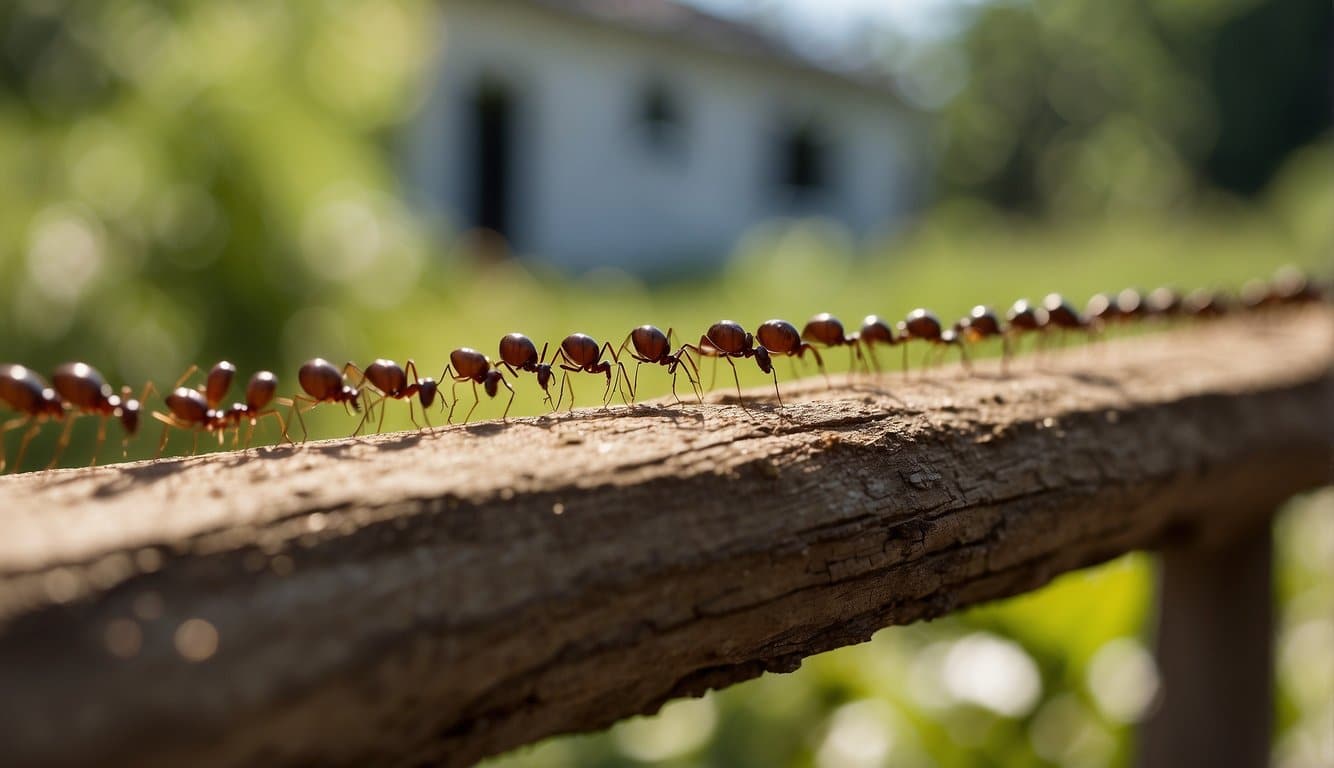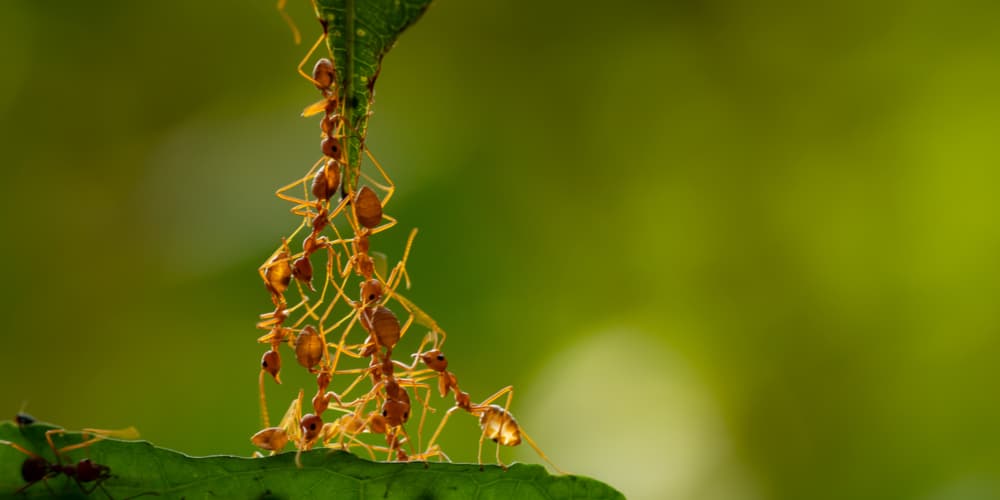What Attracts Ants
Ants are social insects with a complex hierarchy and communication system, essential for their survival and ability to invade homes. They are persistent in their quest for resources, which can lead to them entering your space.
- Scouts: These are the pioneers that search for food sources. Upon finding sustenance, they report back to the colony.
- Pheromone Trail: Scouts lay down an invisible chemical trail, which contains pheromones, to lead others to the found feast.
- Colony: A collective mass that works in unison, thanks to the pheromone paths provided by their scouts.
To keep these tiny intruders at bay, it’s imperative to disrupt their scouting missions and eliminate their trails. Here’s what you can do:
- Cleanliness: Maintain a spotless home, especially free of food residues, to not attract scouts.
- Seal Entrances: Regularly inspect and seal any cracks or crevices that could serve as gateways for ants.
- Disrupt Trails: Clean surfaces where you’ve seen ant activity to mess with their navigation.
Understanding ant behavior and disrupting their communication can help in keeping them out of your home for good. By taking proactive measures, you minimize the risk of these tiny creatures marching into your living space.
Preventing Ants
Effective ant prevention in your home requires a strategic approach. Here’s what you need to focus on to keep ants at bay permanently.
Secure Food Sources
- Store your food in airtight containers to prevent attracting ants. This includes items like sugar, honey, and pet food which are ant favorites.
- Regularly wipe down kitchen surfaces and sweep floors to clear any crumbs or food spills.
Eliminate Water Sources
- Fix leaks and damp areas around sinks and tubs, as ants are drawn to moisture.
- Dry out sink areas and don’t leave standing water in pots or trays.
Fortify Entry Points
- Seal cracks in doors, windows, and foundation to block entry points.
- Consider a professional landscaper to assess and mitigate potential entry points from the outdoors.
Maintain Cleanliness and Organization
- Implement cleaning and organizing tips such as regular dusting and vacuuming to leave no trace for ants.
- Dispose of garbage promptly, especially if it contains food remnants.
Landscaping and Outdoor Strategies
- Keep your yard neat, trimming back plants from your home’s exterior to reduce ant access.
- Explore natural ant repellents like vinegar around the perimeter of your home.
ID And Treat Infestations
Identifying and treating ant infestations promptly is key to keeping your home ant-free. Know the signs, use effective methods, and select the right repellents—whether natural or chemical.
Recognize Signs of Ant Infestation
- Activity: Regular sightings of ants in your home, particularly in the kitchen or bathroom, often indicate an infestation.
- Trails: Ants follow invisible pheromone trails to food sources. Noticing these trails means ants have established a path into your home.
- Nest Sites: Look out for small piles of dirt or debris indoors which may signal nest sites, especially in relation to carpenter ants, as they cause damage to wood.
- Wood Damage: Sawdust-like material, known as frass, near baseboards or wood structures may be a sign of carpenter ants or termites.
Effective Ant Control Methods
- Ant Baits: Use ant bait stations to combat your infestation. Ants take the bait back to the colony, which can effectively
get rid of ants at the source. - Contact Insecticide: For immediate results, a direct application of insecticide to visible ants and entry points can be effective.
- Professional Extermination: Sometimes it’s best to call an exterminator, especially for stubborn infestations or those involving wood-loving species like carpenter ants.
Natural and Chemical Repellents
- Vinegar: A solution of vinegar and water can help disrupt ant trails and prevent future infestations.
- Diatomaceous Earth: Sprinkle food-grade diatomaceous earth around entry points to dehydrate and kill ants that come into contact with it.
- Essential Oils: Peppermint oil, citrus oil from peels, and cayenne pepper are known to repel ants.
- Boric Acid: Create a home-made bait by mixing boric acid powder with sweeteners like honey. Use this cautiously as it can be toxic if ingested by pets or children.
In tackling ant problems, a combination of identifying the signs of an infestation, using direct and bait-based control methods, and applying both natural and chemical repellents will increase your chances of success.
Ongoing Management and Professional Advice
To maintain an ant-free home, a combination of vigilance and professional insights is key. You’ll need to stay proactive and call for expert help when necessary.
Regular Inspection and Housekeeping
Stay Alert: Conduct regular checks in and around your home to spot early signs of ant activity.
- Identify Ant Trails: Look for trails that lead to food sources — these are highways for ant activity.
- Ant Baits and Traps: Strategically place ant baits and traps along these paths and in areas where ants are frequently observed.
- Examine Houseplants: Check your houseplants regularly as they can harbor ants and other pests.
Cleanliness is Crucial:
- Vacuum Regularly: Ensure you vacuum your home to remove potential ant attractants like food crumbs.
- Cleaning Tips:
- Wipe down surfaces to disrupt pheromone trails.
- Store sweets in sealed containers to deter ant invaders.
Seek Professional Advice:
- Consult an Exterminator: If ant infestations persist, contact a licensed exterminator.
- Entomologist Insights: For particularly troublesome or persistent invasions, seeking advice from an entomologist may reveal specific methods tailored to the ant species in your home.
By integrating consistent housekeeping with specialized knowledge from pest control experts, you’re well-equipped to keep ants out for good. Remember, tackling the issue early with these methods significantly reduces the likelihood of a full-blown infestation.
Frequently Asked Questions
In this section, we cover top queries on keeping ants out with effective methods and substances, ensuring your home remains an ant-free zone.
What are the most effective natural remedies for repelling ants from the home?
To naturally repel ants, consider the following:
- Mixing a solution of borax and sugar can effectively lure and eliminate ants. Combine 1/2 teaspoon borax with sugar and warm water to create a homemade bait.
- Creating a spray with essential oils like peppermint can deter ants due to their strong dislike of the scent.
Which smells have been proven to keep ants away?
Ants are repelled by strong scents, particularly those of essential oils. Scents that ants find unattractive include:
- Peppermint oil, a natural option, also adds a fresh fragrance to your home.
- Vinegar, when mixed with water, acts as a deterrent and is helpful for cleaning away ant trails.
What are the best practices to prevent ants from entering the home?
To prevent ants from invading your space, you should:
- Ensure cleanliness by regularly sweeping up food crumbs and wiping spills.
- Seal entry points such as cracks and crevices around doors, windows, and foundations to block their access.
What substances do ants detest that can be used for household ant prevention?
Certain household items are disliked by ants and can assist in prevention:
- Using chalk or talcum powder along entry points is known to disrupt their pheromone trails.
- Placing cucumbers near entry points, as ants dislike the bitter compound cucurbitacins in them.
How can one quickly eliminate ant infestations in the home?
For a swift response to an ant infestation, consider these steps:
- Setting out ant baits is a highly effective strategy for controlling an ant problem.
- Spraying a mixture of dish soap and water directly onto the ants, which suffocates and kills them on contact.
Are there any permanent solutions to halting ant invasions within residential areas?
Long-term solutions to ant invasions emphasize prevention:
- Regularly inspecting and maintaining your home to repair any potential entry points.
- Professional pest control services that offer comprehensive treatment and ongoing prevention plans.
Last update on 2025-04-19 / Affiliate links / Images from Amazon Product Advertising API




